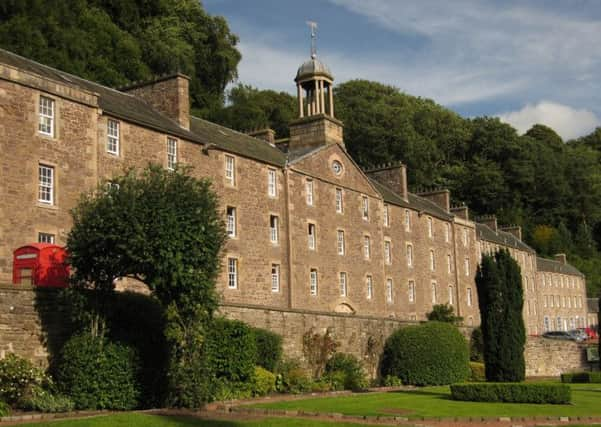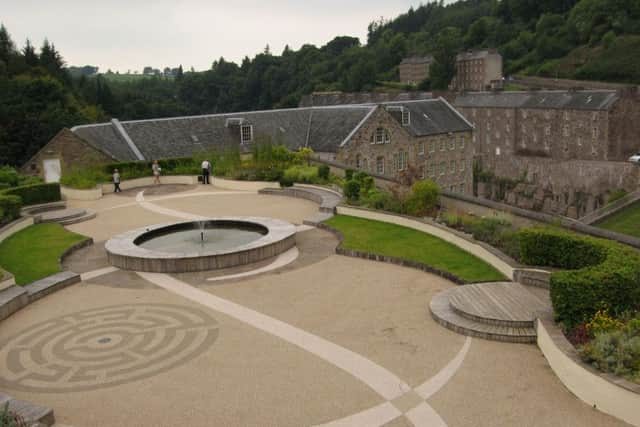Scotland: Industrial sights


The only spinning that takes place in the 220-year-old cotton mills at New Lanark these days is the sort that involves exercise bikes in a hotel fitness centre. Next door, on the ground floor of the former mill number one, two rows of eight original iron pillars flank a swimming pool alongside a new pillar for disabled access. How times change.
Having ceased production in 1968 and subsequently come close to demolition the mill was converted into a three-star hotel in the 1990s and the whole village later designated as a UNESCO World Heritage Site. Barrel vaulted ceilings and Georgian iron windows throughout the 38-bedroom hotel are a constant reminder of its previous incarnation as a mill developed by Welshman Robert Owen along with all of New Lanark.
Advertisement
Hide AdAdvertisement
Hide AdI arrived at the village not knowing who he was and left supporting the campaign to have his image on banknotes. He was a remarkable man, spreading his ideology with an evangelistic zeal. At New Lanark, around 25 miles south east of Glasgow, he demonstrated extraordinary forward thinking in areas such as health and safety, equal opportunity and social welfare. His village shop was the inspiration for the co-operative movement and he developed the world’s first nursery school at the mill. And all this decades before Rowntree, Lever and the other more celebrated philanthropists.


My family and I began our tour of New Lanark at the Annie McLeod Experience. A holographic ghost of Annie told the story of the village with the aid of various tableaux while we watched from suspended seats that trundle round like those at the Jorvik Viking Centre in York.
For a realistic evocation of the mill in its industrial heyday we went next door to see a loom in action. At full throttle a week’s production of cotton could’ve stretched around the globe two-and-a- half times. Everywhere threads and bobbins were in constant motion. Trying to work out what went wrong when the machine grinds to a halt must be as challenging as diagnosing a faulty PC.
A 9,000 sq ft roof garden on the mill includes 70 different plants and shrubs as well as sculptures. It’s not quite as incongruous as it seems since Owen had a keen interest in nature and creativity. The school includes reproductions of his giant roll down banners depicting lions, tigers and other exotic animals. We also saw the gallery with ornate iron rail from which musicians played for children who, at Owen’s instigation, danced for 45 minutes from 7.15 every morning before starting work. The gallery is one of the few original fixtures and features at New Lanark that survived its demise.
Advertisement
Hide AdAdvertisement
Hide AdOur passport ticket gave us admission to several other buildings. They include Owen’s house, the shop, a millworker’s house complete with “stairhead cludgie” (a 1930s toilet) and the equally wonderfully named Institute for the Formation of Character, parts of which are now used for wedding receptions – and dancing of an all together different variety.
Owen’s spirit lives on at New Lanark. Some 45 of the residential properties are let by the New Lanark Trust and part of a row of old workers’ tenements is now a youth hostel. Inevitably, though, in a village that once housed 2,500 people some properties remain empty. Restoration costs must be a considerable barrier to further conversion and the mill’s relative isolation similarly prohibitive.
New Lanark is a very enclosed community both ideologically and topologically. The approach road plunges down hairpin bends to the bottom of the valley where the village is sited and the River Clyde flowed with sufficient force to power the mills’ water wheels.
The following morning we enjoyed a gentle, waymarked walk in the Falls of Clyde nature reserve managed by the Scottish Wildlife Trust. Georgians and Victorians were enthralled by the spectacle of the wooded gorge and its three waterfalls by the ruins of Corra Castle. We also passed Bonnington Pavillion, once adorned internally with mirrors to reflect the vista below. The building was subsequently modified to make way for engineering works for the construction of the UK’s first commercial hydro-electric scheme in the 1920s.
Advertisement
Hide AdAdvertisement
Hide AdThere can be few places where industry and nature work in such harmony as New Lanark and we left drawing inevitable comparisons to the 21st-century focus on renewable energies. We weren’t away for long. The following weekend we were back to break our return journey. Its location, roughly halfway between Yorkshire and the Scottish Highlands plus its proximity to the M74, was our initial reason for staying there but it certainly wasn’t the only one.
• New Lanark Mill Hotel. newlanarkhotel.co.uk. Family rooms cost £119 per room per night including breakfast.
New Lanark World Heritage Site. newlanark.org. Passport ticket for family of four costs £24.50. You can use the ticket on separate visits.
Falls of Clyde. Free walk map available from visitor centre or downloadable from scottishwildlifetrust.org.uk/reserve/falls-of-clyde.